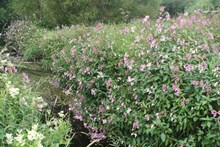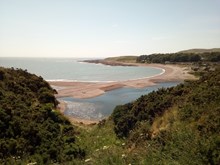16 July, 2018
Removing flowers to keep Inverbervie beautiful!
It might sound odd, but volunteers are being asked to come along and remove flowers to improve Inverbervie’s countryside.
The non-native Himalayan balsam flower, while attractive, is an invasive species which is beginning to take hold on the banks of the River Bervie at Inverbervie. When established it grows in such dense patches it shades out all the native flowers and in winter dies back leaving the riverbanks bare and prone to soil erosion.
The Scottish Invasive Species Initiative (SISI), in collaboration with Brighter Bervie and Inverbervie Angling Association, is asking the community to come out in force on Sunday 29th July to help remove the Himalayan balsam pest.
Working with the Esks Rivers Trust, SISI Project Officer Mark Purmann-Charles said; “Himalayan balsam originally escaped from gardens and has been spreading ever since throughout the countryside causing problems for our native wildlife - but we are taking action and aiming to remove it from the Inverbervie Bay area with the help of the community. It has a really shallow root system which makes it easy to pull out of the ground by hand, so anyone, young and old, can come along and help. It’s actually quite a fun activity to get involved with – no experience required! I’ll also be showing people how we control another invasive plant, the Japanese knotweed, using stem injectors, and, with the help of the Inverbervie Angling Association, we’ll be launching a mink raft to help us in our efforts to control the predatory American mink.”
Tom Campbell from the Brighter Bervie community volunteer group explained the importance of the work for the area; “Removing invasive species will really help improve our local countryside. Inverbervie is entered in the 2018 Keep Scotland Beautiful Awards, and the judging includes not just floral displays and our green spaces, but our commitment to the wider environment and conservation, and community participation, so we are hoping for a really good turnout for this event – after all many hands make light work!”
Everyone is welcome to come along, volunteers are asked to meet at the Bervie Footbridge on Sunday 29th July at 10 am, and to bring gardening gloves. For further information about the event please contact Mark at markeskrivers@gmail.com or Tom at brighterbervie@hotmail.com
Volunteer & Communications officer with the SISI project, Vicky Hilton, added; “We are delighted to be working in partnership with these local groups, and we welcome approaches from communities like Inverbervie who want to collaborate on projects like this to achieve a common goal. The SISI project is also supporting lots of individual volunteers with gaining training and experience so invasive species can be managed at a local level. If you’d like to discuss any opportunities further, you can get in touch by emailing us at SISI@snh.gov.uk”
The Scottish Invasive Species Initiative (SISI) is a 4-year partnership project, led by Scottish Natural Heritage, with funding from the Heritage Lottery Fund, and working with many fisheries trusts and boards. SISI is working throughout northern Scotland from the Tay catchment in the south to the remote catchments of North West Sutherland.
Contact information
- Name
- Carrie Wieteska
- Carrie.Wieteska@nature.scot
Notes to editors
MEDIA CONTACT:
Vicky Hilton, 01309 611220 / 07340 373211
Photos credit: (c) SISI Project
The Scottish Invasive Species Initiative (SISI) is a four-year partnership project in northern Scotland led by Scottish Natural Heritage (SNH) and involving many fishery boards and trusts1 and the University of Aberdeen. SISI is funded by the Heritage Lottery Fund and Scottish Natural Heritage.
The total value of the project is £3.34 million. Funding is from the Heritage Lottery Fund (£1.59m) and Scottish Natural Heritage (£500k), with in-kind funding from the Fisheries Trusts and volunteer time (£1.25m).
The project area encompasses over a third (37%) of Scotland. This is focused in northern Scotland and covers an area of approx. 29,500 km2 from the Tay catchment in the south to the remote catchments of north-west Sutherland.
SISI has provided employment for five full-time and two seasonal staff, and is also supporting existing staff time within fishery trusts and boards.
SISI will take a partnership approach to ensure effective large-scale co-ordinated invasive species control, engaging with organisations, communities and volunteers.
The target INNS species of the SISI project are; American mink (Neovison vison), Giant hogweed (Heracleum mantegazzianum), Japanese knotweed (Fallopia japonica), Himalayan balsam (Impatiens glandulifera), American skunk cabbage (Lysichiton americanus), White butterbur (Petasites albus) and Coneflower (Rudbeckia sp.).
1Fishery Trust / Board Partners; West Sutherland Fisheries Trust, Wester Ross Fisheries Trust, Cromarty Firth Fisheries Trust, Ness & Beauly Fisheries Trust, Findhorn Nairn & Lossie Fisheries Trust, Spey Fishery Board, Deveron Bogie & Isla Fishery Trust, River Dee Trust, Esks Rivers and Fisheries Trust and Tay District Salmon Fishery Board.
NatureScot is Scotland's nature agency. We work to enhance our natural environment in Scotland and inspire everyone to care more about it. Our priority is a nature-rich future for Scotland and an effective response to the climate emergency. For more information, visit our website at www.nature.scot or follow us on X at https://x.com/NatureScot
’S e NatureScot buidheann nàdair na h-Alba. Bidh sinn a’ neartachadh àrainneachd na h-Alba agus a’ brosnachadh dhaoine gu barrachd suim a chur ann an nàdar. Tha e mar phrìomhachas againn gum bi nàdar na h-Alba beairteach agus gun dèilig sinn gu h-èifeachdach le èiginn na gnàth-shìde. Tha an tuilleadh fiosrachaidh aig www.nature.scot no air X aig https://x.com/NatureScot


